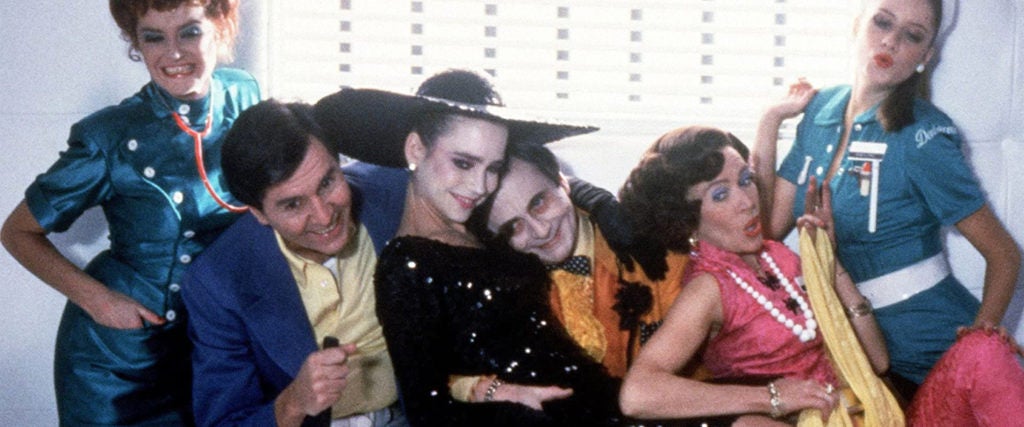Crimped hair, aerobicise and President Ronald Reagan: The 1980s gave us a lot of things, good and bad, but among the very best were a string of the weirdest, most WTF movie musicals ever to hit the silver screen.
The weird musical blitz of the 1980s was, in a way, fated. Blame it on Julie Andrews: In 1965, The Sound of Music was a massive success, quickly surpassing Gone with the Wind as the highest-grossing movie of all time. Predictably, studios doubled down on lavish studio musicals, paying ever more money for things like Clint Eastwood wandering aimlessly through the forest singing about trees.
20th Century Fox hit gold with The Sound of Music, but just two years later the studio was almost bankrupted by Doctor Dolittle. The movie musical was in a coma: Nineteen of them cracked the top 100-grossing films in the 1960s, but in the 1970s, that number was down to eight.
Fortunately for John Travolta, poodle skirts and life on the Earth as we know it, one of those movies was Grease. The tale of star-crossed teen lovers sha-bopping their way through high school became the highest-grossing movie of 1978 and revitalized the musical genre, a fact that Allan Carr — Grease producer and a member of the High Court of Weird 1980s Musical Canon — wasn’t above frequently bragging about. Carr ushered in the 1980s with his next film, Can’t Stop the Music, a disjointed and delirious musical about the Village People. To direct, Carr chose actress Nancy Walker, a comedy veteran who’d never directed a film before and who left Can’t Stop’s New York premiere early because — relates critic Robert Osborne in the doc The Fabulous Allan Carr — “You don’t think I’m going to sit though this piece of shit, do you?”
Said Carr at the time, “Grease was like being in high school and making a movie. [Can’t Stop the Music] was like going to college and making a movie.” That’s true, at least in the sense that there were a lot more illegal drugs involved. Michael Childers, a photographer on the film, said, “Everyone referred to this movie as Can’t Stop the Cocaine.” (You’d need a lot of the stuff to go around for sequences like the YMCA number, a Busby Berkeley-inspired frenzy with dozens of young, scantily-clad beefcakes taking the place of chorus girls.) As with Grease, Can’t Stop the Music mixed the pop culture of the 1980s with a mid-century aesthetic — in Can’t Stop’s case, pairing lavish, MGM-inspired musical numbers with the Village People and Steve Guttenberg in short-shorts. (Something else Louis B. Mayer probably couldn’t have anticipated: a tie-in Baskin Robbins ice cream flavor called “Can’t Stop the Nuts.”)
Other 1980s musicals would also go hard on the nostalgia factor. These included Steve Martin-starrer Pennies from Heaven, which had its stars lip sync to Depression-era standards; Xanadu, which trotted Gene Kelly out for one final film; remake Little Shop of Horrors, which retains its original’s 1960s setting; and the British musical Absolute Beginners, which follows an emerging photographer through the early days of London’s swinging youth culture. That film sprinkles its musical numbers through the plot in a haphazard, almost random way that adds very little to the experience — see a recreation of the Notting Hill race riots that breaks out into a West Side Story-style ballet number — but hey, we get David Bowie dancing on a giant typewriter. Director Julien Temple also helmed 1988 rom-com musical Earth Girls Are Easy, wherein Geena Davis boinks an alien Jeff Goldblum.
The 1980s, following the grand tradition of Elvis movies and A Hard Day’s Night, loved a good rock star musical. Aside from Bowie in Absolute Beginners and Labyrinth, there’s Prince in Purple Rain and Under the Cherry Moon. On the animation side, you have Pink Floyd: The Wall and Rock & Rule, the latter with Debbie Harry as the singing voice of a post-apocalyptic cat girl who summons demon Iggy Pop.
And on the claymation side, there’s Moonwalker, a proto-visual album that loosely knits music videos from Michael Jackson’s Bad album with a subplot involving Joe Pesci as the leader of a paramilitary death squad, looking like he’s straight out of Johnny Mnemonic. The claymation bit comes from the “Speed Demon” segment, wherein Jackson is chased through a studio lot by fans, paparazzi and, of all things, the Domino’s Noid before engaging in a dance-off with a claymation rabbit version of himself. Elsewhere, we see the “Bad” music video recreated with kids, some of whom sport sprayed-on facial hair. Oh, and also he’s a… Transformer?
Four years after the monster success of Grease came Grease 2, notable for giving Michelle Pfeiffer her first leading role and for putting her in perhaps one of the most boringly-staged musical numbers ever. (The number still works, because “Cool Rider” is a good song and, hey, it’s Michelle Pfeiffer.) Grease 2 gave Allan Carr his second flop in a row (coming out the exact same day as E.T. didn’t help). But Carr wasn’t the only filmmaker to fly too close to musical insanity and get singed to a crisp. The writer/director duo of Richard O’Brien and Jim Sharman tried to recreate the cult success of The Rocky Horror Picture Show with 1981 sequel Shock Treatment, a toothless satire of commercialism and TV celebrity that doesn’t have Tim Curry, Susan Sarandon or Barry Bostwick, but does have a higher budget and a whole song called “Looking for Trade.”
And then there’s The Apple.
Released in 1980, The Apple envisions the bright and glistening future of 1994, when the world is controlled by a giant music corporation called Boogalow that lures into its claws an innocent young singer named Bibi (Catherine Mary Stewart). The Apple was written, directed and co-produced by Menahem Golan, co-founder of legendary schlock outfit Cannon Group. Golan thought he had the next Tommy; instead, he got a movie so bad that people at the premiere threw the free soundtracks they’d been given so hard they embedded into the screen. Bizarre and lacking anything remotely in the neighborhood of subtlety — two characters have a sexual encounter to a song called “Coming for You,” while a high-energy, poppy rock anthem called “Speed” proclaims that America “is shooting up with pure energy / and every day she cries out for more speed” — The Apple, along with many other weird 1980s musicals, has developed a well-deserved cult following in the years since its release.
Golan, as detailed in the documentary Electric Boogaloo: The Wild, Untold Story of Cannon Films, may not have really understood Hollywood or American tastes, but even veteran directors were getting tripped up. Paramount executive Robert Evans desperately wanted the film rights to the hit Broadway musical Annie. When he didn’t get them, he turned instead to a classic comic strip that they already owned: Popeye. To direct, he tapped Robert Altman, who, with his naturalistic style, wasn’t exactly the most obvious choice to direct a musical about a sailor who goes turbo-mode when he eats spinach. (Evans later conceded that Altman was “not a studio filmmaker,” but he wanted him anyway because “He hadn’t had a good run right before that. … I love getting a filmmaker whose last pictures haven’t done well. They are usually more collaborative.”)
1980’s Popeye, against all odds, became an Altman film that feels like an Altman film: Its stylized, detailed visual aesthetic pairs with stripped-down songs from Harry Nilsson to create a dour, yet sweet meditation on the resilience and spirit required just to get through each day’s series of indignities. (But for kids!)
Weird 1980s musicals transcended studios and national borders, too. One of the under-appreciated champs of the sub-genre is Japanese film The Legend of the Stardust Brothers (1985), a biopic of a fictional pop duo with Looney Tunes-style humor. And it’s easy to see why John Waters is a fan of 1984’s Voyage of the Rock Aliens, an alien-visitation flick with Pia Zadora, Jermaine Jackson and a giant tentacle monster. Also present is Ruth Gordon, who, 16 years after her Oscar-winning turn in Rosemary’s Baby, shows up in a movie where a robot alien disguised as a fire hydrant pisses on a dog.
The list of the 100 highest-grossing films of the 1980s includes 13 musicals, of which only two — The Blues Brothers and Annie — crossed the $50 million mark. The end of the brief, sublime age of the weird 1980s musical was brought about less by any particular flop than by a slow slide into red ink, paired with one film doing particularly well. In 1989, The Little Mermaid kicked off the Disney Renaissance and ushered in a new age of animated films that would come to dominate the movie musical landscape through the 1990s.
Turns out you can’t stop the music — but you can tune it to the kiddie station.

